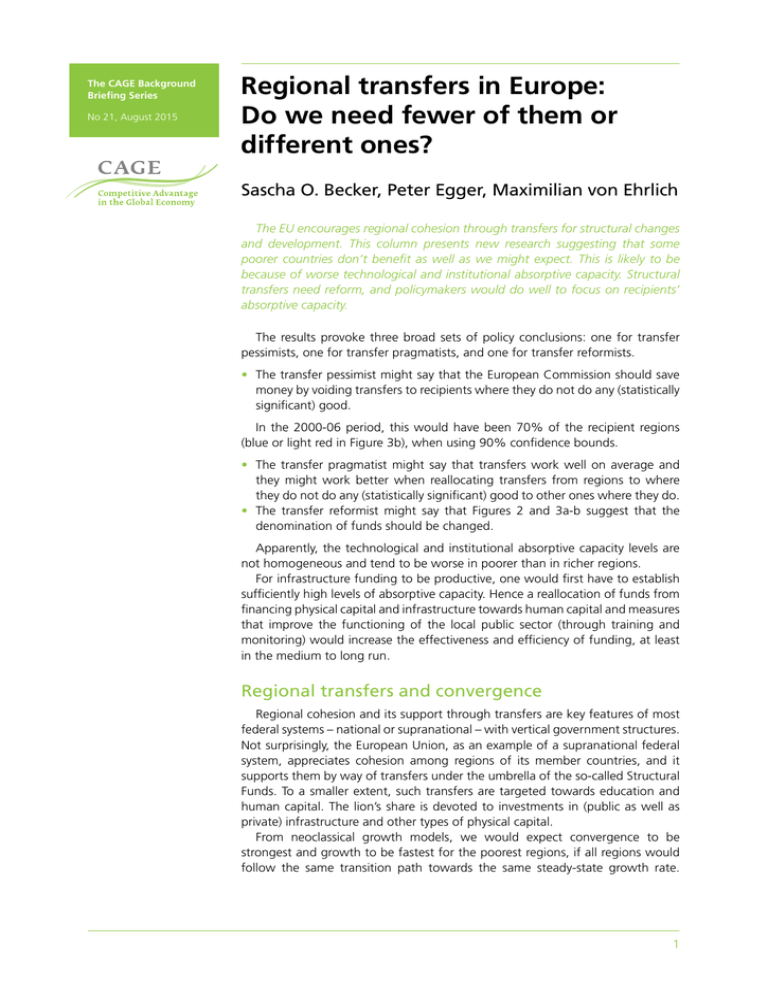Regional transfers in Europe: Do we need fewer of them or
advertisement

The CAGE Background Briefing Series No 21, August 2015 Regional transfers in Europe: Do we need fewer of them or different ones? Sascha O. Becker, Peter Egger, Maximilian von Ehrlich The EU encourages regional cohesion through transfers for structural changes and development. This column presents new research suggesting that some poorer countries don’t benefit as well as we might expect. This is likely to be because of worse technological and institutional absorptive capacity. Structural transfers need reform, and policymakers would do well to focus on recipients’ absorptive capacity. The results provoke three broad sets of policy conclusions: one for transfer pessimists, one for transfer pragmatists, and one for transfer reformists. • The transfer pessimist might say that the European Commission should save money by voiding transfers to recipients where they do not do any (statistically significant) good. In the 2000-06 period, this would have been 70% of the recipient regions (blue or light red in Figure 3b), when using 90% confidence bounds. • The transfer pragmatist might say that transfers work well on average and they might work better when reallocating transfers from regions to where they do not do any (statistically significant) good to other ones where they do. • The transfer reformist might say that Figures 2 and 3a-b suggest that the denomination of funds should be changed. Apparently, the technological and institutional absorptive capacity levels are not homogeneous and tend to be worse in poorer than in richer regions. For infrastructure funding to be productive, one would first have to establish sufficiently high levels of absorptive capacity. Hence a reallocation of funds from financing physical capital and infrastructure towards human capital and measures that improve the functioning of the local public sector (through training and monitoring) would increase the effectiveness and efficiency of funding, at least in the medium to long run. Regional transfers and convergence Regional cohesion and its support through transfers are key features of most federal systems – national or supranational – with vertical government structures. Not surprisingly, the European Union, as an example of a supranational federal system, appreciates cohesion among regions of its member countries, and it supports them by way of transfers under the umbrella of the so-called Structural Funds. To a smaller extent, such transfers are targeted towards education and human capital. The lion’s share is devoted to investments in (public as well as private) infrastructure and other types of physical capital. From neoclassical growth models, we would expect convergence to be strongest and growth to be fastest for the poorest regions, if all regions would follow the same transition path towards the same steady-state growth rate. 1 Regional transfers in Europe: Do we need fewer of them or different ones? An absence of this pattern would suggest different long-term growth paths or impediments to convergence in the short run. At least the former might create problems in a federation with more or less (policy-) frictionless goods trade and factor movements such as the European Union. Clearly, there was a large gap in per-capita income across countries and regions in the member states of the European Union in its wake and the dispersion persists. One reason for it might be a gap in the quality and existence of infrastructure (for transportation and production) in Europe. Then, transfers could help stimulate convergence by equalising the availability and quality of that infrastructure. Yet, investment in infrastructure which connects the poor regions to the prospering core regions may also enhance inequalities (see Martin 1999). 1989 – 93 .0001 1994 – 99 2000 – 06 .00005 Density .00015 .0002 Figure 1. Distribution of per-capita GDP (at purchasing power parity) across European NUTS2 regions in three program periods 0 10000 20000 30000 40000 GDP per capita Institutional design of regional transfers in the European Union The European regional policy is administrated along budgetary periods of five to seven years. Concerning its volume, regional policy constitutes the secondlargest item (after agricultural policy) in the EU’s federal budget. On average, between 1994-2006 these transfers amounted to about 0.7% of GDP per recipient region. About 70% of these funds were allocated to the so-called Objective 1 program which aims at supporting convergence of the regions with the lowest per-capita income towards the EU average. Eligibility for Objective 1 transfers is generally determined at the level of NUTS2 regions which are entities of 0.8-3 million inhabitants. Between 1989 and 2006, Objective 1 regions received transfers of about 1.7% of regional GDP. In the following, we focus on Objective 1 transfers in the budgetary periods 1989-93, 1994-99, and 2000-06. In the three periods 58, 64, and 101 NUTS2 regions in our sample (or 30%, 30%, and 39%, respectively) received Objective 1 transfers. The number of recipient regions was increasing due to enlargements of the EU and the associated bigger variance in regional per-capita income (see Figure 1). 2 Regional transfers in Europe: Do we need fewer of them or different ones? Justification of regional transfers Clearly, for an economic justification of inter-regional transfers, two concepts are key: their effectiveness and their efficiency. In the context of Structural Operations, this raises questions about: • Whether they facilitate convergence of poorer net recipient regions towards the other ones on average. • Whether this convergence is sustainable, i.e., goes beyond a short-term consumption effect. • Whether the induced convergence is more or less homogeneous across recipients and, if not, where it is more and where less effective. Identification of causal effects of transfers Previous empirical work by Boldrin and Canova (2001) did not find any growth effects of transfers beyond short-term consumption stimuli. MidelfartKnarvik and Overman (2002) found that EU transfers helped countries attracting industries which used research and development intensively, but at the expense of medium-skilled industries. Yet, while the analysis in these papers suggested certain correlations, it did not permit a causal interpretation. Evaluating transfers is difficult for the same reason as medication for heart patients is difficult: it is the poor regions which get transfers and it is the sick people who take medication against heart disease. This pattern will induce a negative correlation between per-capita income and transfers and, in comparison, heart medication and health status that precludes causal inference. With heart patients we can do clinical studies to avoid this problem with true and placebo treatments. This is what we call randomisation. Such an experiment, and true randomisation, is politically infeasible with transfers among regions. Regions are eligible to Objective 1 transfers only if their per-capita income falls short of 75% of the Union’s average per-capita income (measured in purchasing power parity). By conditioning on just-eligible and just-not-eligible regions in the neighbourhood of this threshold, we might come as close as possible to a randomised experiment, often referred to as quasi-randomisation. The effect of Structural Operation transfers in Europe Becker, Egger, and von Ehrlich (2010) showed that Objective 1 transfers induce growth and income beyond a simple consumption effect: one euro of transfers generates between 1.00 and 1.20 euros on average, so that one could check on the first two prerequisites for an economic justification of transfers. However, this average positive treatment is not necessarily uniform across regions. Becker, Egger, and von Ehrlich (2013) show that transfers affect regional per-capita income growth quite heterogeneously, and that this heterogeneity has a systematic pattern with two dimensions of absorptive capacity: technological absorptive capacity (human capital endowments) and institutional absorptive capacity (the absence of corruption and weak administrative processes). 3 Regional transfers in Europe: Do we need fewer of them or different ones? Figure 2. Significance of Objective 1 transfer effects and absorptive capacity Human Capital (deviation from mean) 0.4 0.3 0.2 0.1 0 -0.1 -0.2 -0.3 -0.4 -3 -2.5 -2 -1.5 -1 -1.5 0 0.5 1 Quality of Government (deviation from mean) Figure 2 contains combinations of technological and institutional absorptive capacity based on all data points NUTS2 recipient regions pooled over the three most recent budgetary periods. In the figure, positive effects are red and negative are blue, and significant effects are dark while insignificant ones are light (using 90% confidence bounds). The figure suggests that significantly positive effects of Objective 1 transfers emerge only for regions with sufficiently high levels of technological as well as institutional capacity. What the figure does not show is that the point estimates of effects tend to be also higher in the dark red regions than in the other ones. Hence, transfer effects increase almost monotonically as technological and institutional absorptive capacity rises. Figure 3a. Average per-capita GDP 2000-06 4 Regional transfers in Europe: Do we need fewer of them or different ones? Figure 3b. Absorptive capacity and the treatment effects of Objective 1 transfers Negative and Significant Negative and Insignificant Positive and Insignificant Positive and Significant How the estimates in Figure 2 map into the geography of Europe is illustrated in Figures 3a and 3b. Figure 3a uses colour to indicate regions’ per-capita income levels for the 2000-06 budgetary period (in purchasing power parity). Shades of red indicate levels above the EU27 average with darker colours referring to higher levels. Shades of blue indicate levels below the EU27 average with darker colours referring to lower levels. Figure 3b assigns the estimates in Figure 2 in terms of the four colors to the same map of the EU27. It is obvious from Figures 3a and 3b that transfer effects are lower (mostly absent) in poorer regions and higher in richer regions which are closer to the non-eligibility threshold. This means that Objective 1 transfers induce convergence mostly for those eligible regions that might need them the least and they eventually stimulate divergence among the recipient regions. In our opinion, this raises a flag at least about the efficiency of cohesion policy. Policy conclusions The results provoke three broad sets of policy conclusions: one for transfer pessimists, one for transfer pragmatists, and one for transfer reformists. The transfer pessimist might say that the European Commission should save money by voiding transfers to recipients where they do not do any (statistically significant) good. In the 2000-06 period, this would have been 70% of the recipient regions (blue or light red in Figure 3b), when using 90% confidence bounds. The transfer pragmatist might say that transfers work well on average and they might work better when reallocating transfers from regions to where they do not do any (statistically significant) good to other ones where they do. The transfer reformist might say that Figures 2 and 3a-b suggest that the denomination of funds should be changed. Apparently, the technological and institutional absorptive capacity levels are not homogeneous and tend to be worse in poorer than in richer regions. For infrastructure funding to be productive, one would first have to establish sufficiently high levels of absorptive capacity. Hence a reallocation of funds from financing physical capital and infrastructure towards human capital and measures that improve the functioning of the local public sector (through training and monitoring) would increase the effectiveness and efficiency of funding, at least in the medium to long run. 5 Regional transfers in Europe: Do we need fewer of them or different ones? References Becker, Sascha O, Egger, Peter H and Maximilian von Ehrlich (2010), “Going NUTS: The effect of EU Structural Funds on regional performance”, Journal of Public Economics 94(9-10), 578-590. Becker, Sascha O, Egger, Peter H and Maximilian von Ehrlich (2013), “Absorptive capacity and the growth and investment effects of regional transfers: A regression discontinuity design with heterogeneous treatment effects”, American Economic Journal: Economic Policy, forthcoming. Boldrin, Michele and Fabio Canova (2001), “Europe’s regions – Income disparities and regional policies”, Economic Policy 16(32), 207-253. Martin, Philippe (1999), “Public policies, regional inequalities and growth”, Journal of Public Economics 73(1), 85-105. Midelfart-Knarvik Karen Helene and Henry G Overman (2002), “Delocation and European integration: is structural spending justified?”, Economic Policy 17(35), 321-359. 6 About CAGE Established in January 2010, CAGE is a research centre in the Department of Economics at the University of Warwick. Funded by the Economic and Social Research Council (ESRC), CAGE is carrying out a five year programme of innovative research. The Centre’s research programme is focused on how countries succeed in achieving key economic objectives, such as improving living standards, raising productivity and maintaining international competitiveness, which are central to the economic well-being of their citizens. CAGE’s research analyses the reasons for economic outcomes both in developed economies such as the UK and emerging economies such as China and India. The Centre aims to develop a better understanding of how to promote institutions and policies that are conducive to successful economic performance and endeavours to draw lessons for policy-makers from economic history as well as the contemporary world. This piece first appeared on Voxeu on 6 June 2013 www.voxeu.org/article/regional-transfers-europe-do-we-need-fewer-them-ordifferent-ones VOX Research-based policy analysis and commentary from leading economists © 2015 The University of Warwick Published by the Centre for Competitive Advantage in the Global Economy Department of Economics, University of Warwick, Coventry CV4 7AL www.warwick.ac.uk/cage Artwork by Mustard, www.mustardhot.com




